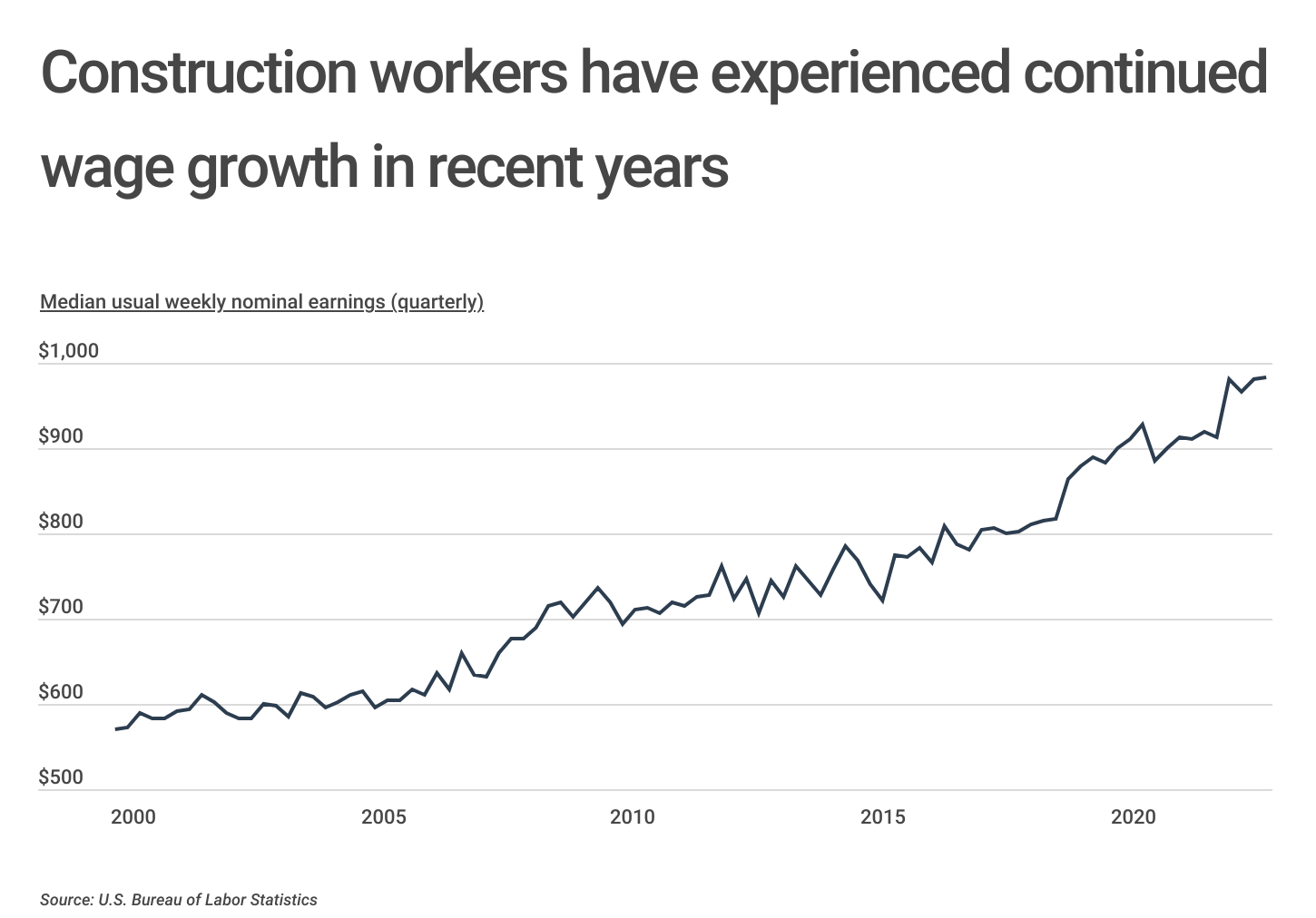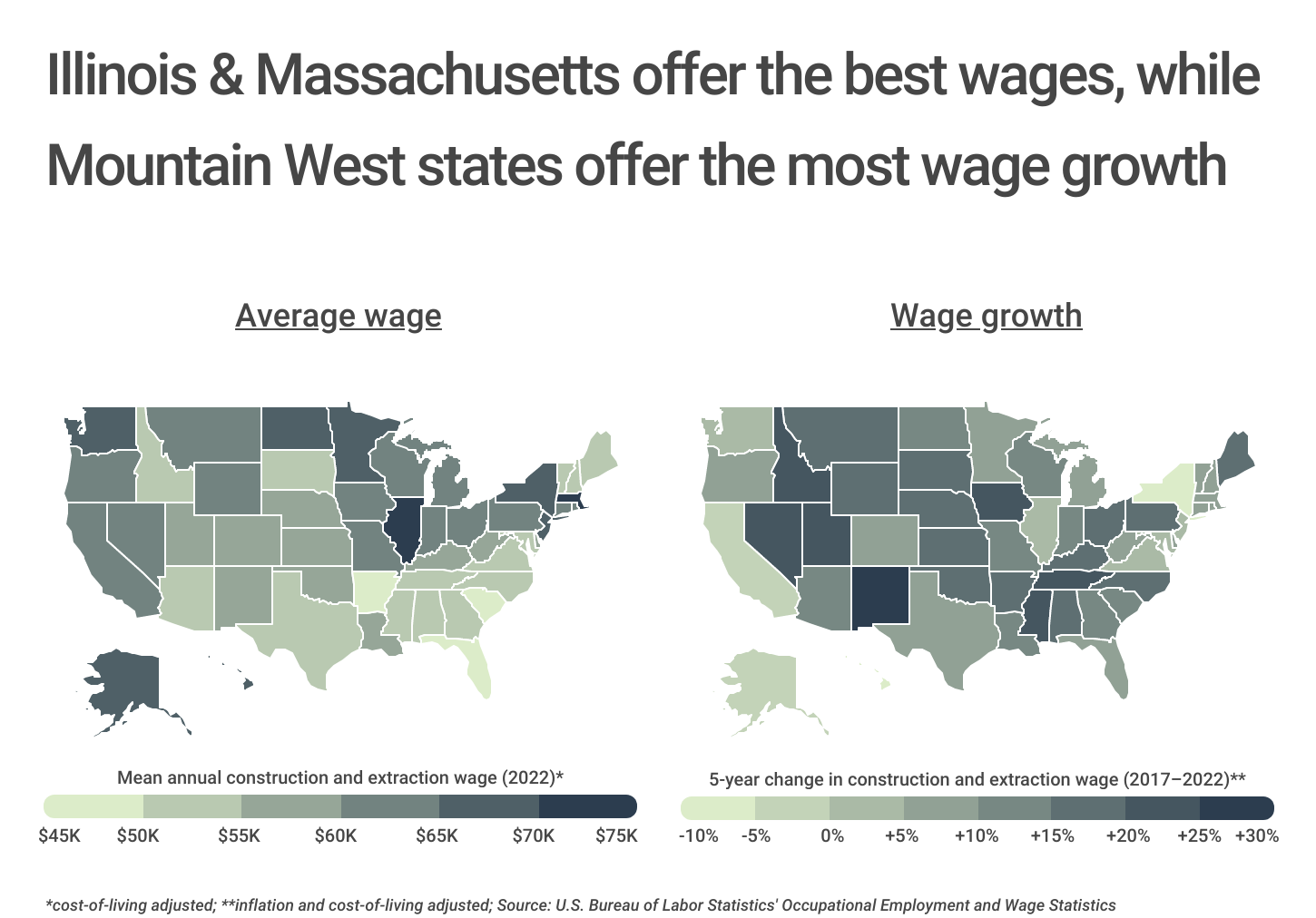Construction Jobs With the Fastest-Growing Wages
Note: This is the most recent release of our Construction Jobs With the Fastest-Growing Wages study. To see data from prior years, please visit the Full Results section below.
The construction industry is a major component of the U.S. economy. From the roads and bridges connecting every corner of the country, to the factories and buildings that the American workforce uses daily, the construction sector has a far-reaching impact. And with federal initiatives to expand the residential housing supply and rebuild America’s aging infrastructure, demand for construction workers is expected to grow.
Despite this bright outlook, the U.S. is in the midst of a skilled worker shortage that is projected to worsen as an already aging construction workforce reaches retirement. To fill the demand, construction firms will need to recruit the next generation of skilled workers.

One way to attract more qualified workers to the construction sector is with increasing pay. Despite the fact that the construction industry already pays well compared to other occupations with similar educational requirements, construction wages are increasing. In April 2023, median weekly earnings for full-time construction and extraction occupations reached an all-time high of $982. That figure is up 7.6% from one year prior (compared to an inflation rate of 4.9% over the same time period), and a sign of the growing demand for skilled workers in the construction industry.
However, when looking at the five-year period ending in 2022—the latest year for which more granular occupation-specific data is available—wages in the construction industry failed to keep pace with inflation. At the national level, across all construction and extraction occupations, mean wages actually fell by 2.0% after accounting for rising living costs.
INDUSTRY TRENDS
Advances in construction technology are changing the job responsibilities for many workers, especially project managers. For example, construction takeoff software automates the process of calculating material quantities from blueprints. Similarly, estimating software more accurately generates project cost estimates based on continuously updated databases of material and labor prices.

Some locations are better than others for construction workers. States with a strong union presence or prevailing wage laws tend to have the highest wages. Most of these locations are found in Northeastern and Western states. Illinois leads the nation with a cost-of-living adjusted mean annual wage of $73,226 in 2022, followed by Massachusetts ($70,846), Alaska ($69,974), and Hawaii ($68,756). In contrast, many of the lowest-paying states are found in the South, including the bottom three states for construction occupations: Florida ($47,412), Arkansas ($49,494), and South Carolina ($49,876).
In terms of wage growth, the Mountain West region saw some of the largest wage gains in the construction industry. New Mexico (+25.9%), Nevada (+23.0%), Idaho (+22.6%), Utah (+21.6%), and Montana (+19.0%) all rank in the top 10 for their increases in mean wages for construction workers from 2017 to 2022. The recent population growth in Mountain West states has likely contributed to increased demand for construction workers to build the housing and infrastructure needed to accommodate the increase in residents.
More so than by location, wages in the construction industry vary widely by occupation, and some roles have shown more recent wage growth than others. To find the construction jobs with the fastest-growing wages, researchers at Construction Coverage analyzed the latest data from the U.S. Bureau of Labor Statistics. The researchers ranked all construction and extraction occupations according to the five-year percentage change in wages from 2017 to 2022. In the event of a tie, the occupation with the higher mean annual wage in 2022 was ranked higher.
Here are the construction jobs with the fastest-growing wages.
The Top 10 Construction Jobs With the Fastest-Growing Wages

Photo Credit: Elizaveta Galitckaia / Shutterstock
10. Floor Layers (Except Carpet, Wood, and Hard Tiles)
- 5-year percentage change in wage (nominal): +23.2%
- 5-year percentage change in wage (inflation-adjusted): No statistically significant change
- Mean annual wage (2022): $54,870
- Mean annual wage (2017): $44,530
- Total employment: 20,710
Official BLS title “Floor Layers, Except Carpet, Wood, and Hard Tiles.” These floor layers apply blocks, strips, or sheets of shock-absorbing, sound-deadening, or decorative coverings to floors.

Photo Credit: Dany cn / Shutterstock
9. Painter, Paperhanger, Plasterer, and Stucco Mason Helpers
- 5-year percentage change in wage (nominal): +24.4%
- 5-year percentage change in wage (inflation-adjusted): No statistically significant change
- Mean annual wage (2022): $38,040
- Mean annual wage (2017): $30,570
- Total employment: 8,630
Official BLS title “Helpers–Painters, Paperhangers, Plasterers, and Stucco Masons.” These workers help painters, paperhangers, plasterers, or stucco masons by performing duties requiring less skill. Some duties include using, supplying, or holding materials or tools, and cleaning work areas and equipment.

Photo Credit: Anna Berdnik / Shutterstock
8. Carpenter Helpers
- 5-year percentage change in wage (nominal): +25.0%
- 5-year percentage change in wage (inflation-adjusted): +4.7%
- Mean annual wage (2022): $38,880
- Mean annual wage (2017): $31,100
- Total employment: 24,580
Official BLS title “Helpers–Carpenters.” These workers help carpenters by performing duties requiring less skill, some of which include: using, supplying, or holding materials or tools, and cleaning work areas and equipment.

Photo Credit: Vova Shevchuk / Shutterstock
7. Floor Sanders and Finishers
- 5-year percentage change in wage (nominal): +25.6%
- 5-year percentage change in wage (inflation-adjusted): No statistically significant change
- Mean annual wage (2022): $49,330
- Mean annual wage (2017): $39,260
- Total employment: 4,270
Floor sanders and finishers prepare and apply finishing coats to wooden floors. They may work with floor scrapers and sanding machines to aid in their work.

Photo Credit: bogdanhoda / Shutterstock
6. Mason, Tile Setter, and Marble Setter Helpers
- 5-year percentage change in wage (nominal): +26.3%
- 5-year percentage change in wage (inflation-adjusted): +5.8%
- Mean annual wage (2022): $44,230
- Mean annual wage (2017): $35,020
- Total employment: 17,730
Official BLS title “Helpers–Brickmasons, Blockmasons, Stonemasons, and Tile and Marble Setters.” These workers help brickmasons, blockmasons, stonemasons, and tile and marble setters by fetching and holding supplies, cleaning up the work area, and maintaining tools and equipment.

Photo Credit: afotostock / Shutterstock
5. Miscellaneous Construction Trade Helpers
- 5-year percentage change in wage (nominal): +28.1%
- 5-year percentage change in wage (inflation-adjusted): +7.3%
- Mean annual wage (2022): $40,790
- Mean annual wage (2017): $31,830
- Total employment: 27,920
Official BLS title “Helpers, Construction Trades, All Other.” These workers help skilled trades workers with activities that require less skill. This occupation category specifically excludes helpers of blockmasons, brickmasons, carpenters, electricians, painters, paperhangers, plasterers, pipefitters, pipelayers, plumbers, roofers, steamfitters, stonemasons, stucco masons, and tile and marble setters.

Photo Credit: David Antonio Lopez Moya / Shutterstock
4. Quarry Rock Splitters
- 5-year percentage change in wage (nominal): +30.4%
- 5-year percentage change in wage (inflation-adjusted): +9.2%
- Mean annual wage (2022): $47,010
- Mean annual wage (2017): $36,050
- Total employment: 3,910
Official BLS title “Rock Splitters, Quarry”. These workers typically separate blocks of rough dimension stone from quarry mass using jackhammers, wedges, or chop saws.

Photo Credit: Pierre-Olivier / Shutterstock
3. Stonemasons
- 5-year percentage change in wage (nominal): +32.4%
- 5-year percentage change in wage (inflation-adjusted): +10.9%
- Mean annual wage (2022): $56,100
- Mean annual wage (2017): $42,370
- Total employment: 10,220
Stonemasons build stone structures, such as piers, walls, and abutments. They may also lay walks, curbstones, or special types of masonry for vats, tanks, and floors.

Photo Credit: Doralin Samuel Tunas / Shutterstock
2. Terrazzo Workers and Finishers
- 5-year percentage change in wage (nominal): +35.5%
- 5-year percentage change in wage (inflation-adjusted): +13.5%
- Mean annual wage (2022): $61,680
- Mean annual wage (2017): $45,520
- Total employment: 1,460
This occupation entails pouring and mixing cement, marble chips, and other materials to create durable and decorative surfaces such as floors, stairways, and cabinet fixtures.
FOR CONSTRUCTION PROFESSIONALS
Tools and equipment insurance, sometimes referred to as contractors equipment insurance, protects businesses that move tools and equipment across job sites as a normal part of their business operations. It’s a type of inland marine insurance, and it provides coverage for construction businesses where both commercial property and general liability insurance fall short.

Photo Credit: Attasit saentep / Shutterstock
1. Roofer Helpers
- 5-year percentage change in wage (nominal): +37.6%
- 5-year percentage change in wage (inflation-adjusted): +15.2%
- Mean annual wage (2022): $40,880
- Mean annual wage (2017): $29,710
- Total employment: 5,790
Official BLS title “Helpers–Roofers.” These workers help skilled roofers by performing lower-level job tasks, such as using, supplying, or holding materials or tools, and cleaning work areas and equipment.
Detailed Findings & Methodology
To find the construction jobs with the fastest-growing wages, researchers at Construction Coverage analyzed the latest data from the U.S. Bureau of Labor Statistics’ Occupational Employment and Wage Statistics. The researchers ranked all construction and extraction occupations according to the five-year percentage change in wages from 2017 to 2022. In the event of a tie, the occupation with the higher mean annual wage in 2022 was ranked higher.
Full Results
Each company featured in our guides has been independently selected and reviewed by our research team. If you select one of these companies and click on a link, we may earn a commission.
By clicking on these links, you may be taken to one of our insurance partners. The specific company listed here may or may not be included in our partner’s network at this time.
